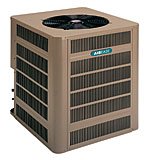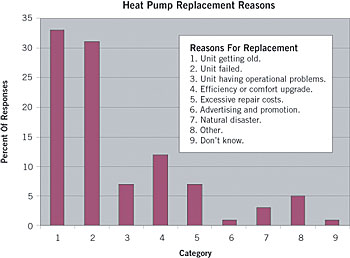
According to Nance Lovvorn of Lovvorn Consulting Services, Birmingham, Ala., "The observed median service life of heat pumps if only removed due to failure [not replaced for efficiency reasons] was approximately 26 years." Lovvorn's information came from a 2001 Alabama Power Co. report, results from which were included in his paper, "Increasing Consumer Confidence in Heat Pumps."
This 26-year median longevity is a far cry from the early days of heat pump installations, particularly in the 1950s and 60s, when early failures led to many redesigns and poor public perceptions of the product.
Even 20 years ago, heat pumps were documented as being replaced before their time. According to a 1985 study from the Electric Power Research Institute (EPRI), "nearly 50 percent of heat pumps that had been removed from service [for any reason] were still operational when removed." The current study shows that the number of units still operational when removed has increased to 63 percent."

Lovvorn reported that in the 1985 study, the average replacement age of total heat pump systems was approximately 13.5 years. "Average age at replacement found in the current study was 18.2 years," Lovvorn said. "Note that in 1985, average age at replacement was less than 70 percent of the median service life. This percentage has now increased to almost 90 percent."
Owner Perceptions
Homeowners might be less willing to wait for a catastrophic failure to replace their heat pumps. It's interesting that even in 1985, 50 percent of units were still operational when replaced. "The foremost reason for replacement was the homeowner's perception that a unit was getting old," Lovvorn said. Whether the perception was based on their own observations of the unit's performance or other market drivers (advertising, contractor information) is not known.
In addition, "Respondent comments clearly indicated that maintenance requirements were down for newer vintage units, while satisfaction was up," Lovvorn stated. "This suggests that equipment improvements have improved heat pump performance and reliability, but have not yet increased service life.
"The reason little service life increase has been observed is probably because replacements are mostly not failure-induced, but rather are due to perceptions of anticipated life on the part of the owner. It appears likely that heat pump median service life would increase if owners simply let them continue to operate instead of replacing them."
From 88 percent to 92 percent of removed heat pumps were replaced with new heat pumps, according to the 2001 study. Figure 2 shows the most frequently cited reasons for heat pump replacements. Respondents could give more than one reason, Lovvorn pointed out, so the results are shown in terms of percentage of responses rather than percentage of units. The most frequently cited reason for replacing units was that the unit was simply getting old in the view of the owner (33 percent of responses). "Failure" was the second most cited reason, at 31 percent.
All other reasons were cited much less frequently. "When analyzed in terms of number of units, failure was a factor in only 38 percent of replacements, and when combined with operational problems, still totaled less than 50 percent."
What is behind the improvement? According to Lovvorn, it's a combination of improved product and installations, the latter due in large part to increased installer education.

Feedback To Contractors
Alabama Power's heat pump interest was sparked in the 1940s, when the units were only used for cooling. The company co-sponsored a grant in 1946 with Southern Research Institute to develop the heat pump's heating capability. By 1959, the company documented sales of 1,275 residential, 443 commercial, and 26 industrial heat pumps.Positive changes, at least as far as installation quality is concerned, were instituted in the 1960s, Lovvorn said. Alabama Power initiated a Certified Dealer Program in 1964 and an Assured Service Heat Pump Program (ASP) in 1967, "whereby the company would offer a 10-year service maintenance program to customers provided the units met certain criteria."
In the Certified Dealer Program, "Dealers signed an agreement whereby they would install the units per the manufacturer's instructions," Lovvorn explained. "However, problems did not go away. Many installing contractors did not live up to expectations, and installations continued to be substandard."
However, "Many products were also substandard," he said, "though proof was to come later."
In 1967 the ASP included binding agreements with manufacturers, wholesale-distributors, and certified dealers, all of whom agreed to abide by published "Manufacturer's Standards," "Standards for Application and Installation of Heat Pump Systems," and "Service to Heat Pump Systems" developed by experts.
"Each dealer had to be recommended by a wholesale-distributor," Lovvorn said, "meaning partnerships existed if problems developed. Each installation was checked by a utility company specialist to ensure conformance to the aforementioned standards. If the installation did not pass the inspection, the installing dealer was asked to correct the deficiencies. If he refused, the wholesale-distributor stepped in to assist and it was ‘bye-bye, Mr. Dealer,'" he said.
If the installation passed its inspection, the customer was offered a 10-year "Assured Service Maintenance Contract." The contract provided for the customer to pay the utility a fixed amount each month and the dealer would perform necessary repairs for up to 10 years.
"The utility hired an engineer from a manufacturer who was intimately familiar with heat pump installation, service, and repair," Lovvorn said. "He laid out a system to code each invoice to include the reason for the call, the servicer's analysis, the corrective actions taken, and a defect code for each defect noted.
"This individual coded every invoice for over 20 years so consistency was present," he continued. "This is all he did for his entire career with the utility." Major cost items were identified. "Compressor failure rates and costs were at the top of the list," Lovvorn said.
"These records provided a methodology to analyze each manufacturer's units, reliability-wise, to determine the types of problems, the frequency of occurrence, and the cost to repair."
Manufacturers were not told how to correct their problems, he said; "however, problems were pointed out regularly. Most manufacturers knew when they had problems; however, some manufacturers appeared to be in denial."
On the plus side, some manufacturers' decision makers openly discussed the issues being experienced in the field. "One manufacturer built a test facility to test incoming components to be used in its products," Lovvorn recalled.
"Virtually all manufacturers came to appreciate the candor and validity and realized what they were being provided was valuable and unavailable from other sources."
Major improvements to the quality of products were made in the 1970s and 1980s, he said. "Installations improved dramatically."

The Training Touch
In the early 1980s, it was time for another major decision: to end the ASP. "Let's see if heat pumps can stand on their own merit," said Lovvorn.The rationale behind the decision, he recalled, was that "Re-sources were being reduced, making checking all installations not possible. Random checks by utility specialists or asking dealers to check their own units proved to be impractical.
"On the positive side, product reliability was much improved, and installations were significantly improved. Customer acceptance of heat pumps was improving. Dealers were doing good work. Heat pump products were reliable."
In order to maintain consistently high quality heat pump installations, in 1986 Alabama Power opened its Heat Pump Training Center (later renamed the HVAC Training Center), to train HVAC contractors on installation and service of heat pumps and other heating-cooling systems.
The 15,000-square-foot main building houses three classrooms, three labs, an auditorium, dining area, computer lab, library, offices, and administrative area.
The facility features 14 heat pumps mounted on casters and used for tasks such as rewiring electrical systems and repiping refrigerant systems.
Simulators include internally metered devices to reflect time and proper troubleshooting procedures, measuring the student's ability to repair potential problems, Lovvorn said.
The center also features a 1,536-square-foot house with a full basement for duct board fabrication training. One half of the house is of Good Cents energy-efficient construction; the other half is conventional construction. Cutaways allow students to see the advantages and disadvantages of both types of construction.
"Has consumer confidence in heat pumps changed? Yes," Lovvorn said emphatically, "and in a very positive way."
Heat pumps sales are up in Alabama, he said. "In 2004, the electric utility represented here had approximately 1.3 million residential customers with approximately 13,000 new customers," all single-family residences.
"Over 60 percent of these new homes installed heat pumps, and over 10,000 heat pumps were installed in the retrofit market."
Publication date: 06/27/2005

Report Abusive Comment